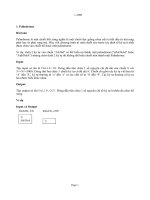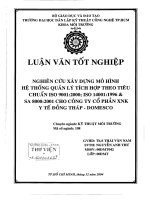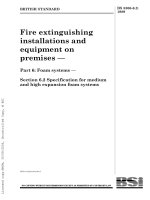Bsi bs au 228 2 1989 (2000) iso 8721 1987
Bạn đang xem bản rút gọn của tài liệu. Xem và tải ngay bản đầy đủ của tài liệu tại đây (346.55 KB, 10 trang )
BRITISH STANDARD AUTOMOBILE SERIES
BS AU 228-2:
1 989
ISO 8721 :1 987
Impact tests on road
vehicles —
Part 2: Specification for measurement
techniques using optical
instrumentation
[ISO title: Road vehicles — Measurement techniques in impact
tests — Optical instrumentation]
UD C 62 9 . 1 1 : 62 0 . 1 /. 1 1 1 . 1
BS AU 228-2:1 989
Committees responsible for this
British Standard
The preparation of this British Standard was entrusted by the Automobile
Standards Committee (AUE/- ) to Technical Committee AUE/7 upon which the
following bodies were represented:
Association for Consumer Research
Automobile Association
Child Accident Prevention Trust
Consumer Policy Committee of BSI
Department of Transport (Highways)
Department of Transport (Transport and Road Research Laboratory)
Institute for Consumer Ergonomics Ltd.
Man- made Fibres Producers’ Committee
Medical Research Council
Ministry of Defence
Motor Industry Research Association
National Automobile Safety Belt Association
Royal Automobile Club
Royal Society for the Prevention of Accidents
Society of Motor Manufacturers and Traders Ltd.
University of Birmingham
This British Standard, having
been prepared under the
direction of the Automobile
Standards Committee, was
published under the authority
of the Board of BSI and
comes into effect on
31 March 1 989
© BSI 01 - 2000
The following BSI references
relate to the work on this
standard:
Committee reference AUE/7
Draft for comment 86/77884 DC
ISBN 0 5 80 1 685 9 X
Amendments issued since publication
Amd. No.
Date of issue
Comments
BS AU 228-2:1 989
Contents
Page
Committees responsib le
National foreword
ii
1
Scope and field of application
1
2
Reference
1
3
D efinitions
1
4
Performance
1
Annex D istortion index measurement methods
2
Figure — Target for distortion index determination
3
Pub lications referred to
© BSI 01 - 2 000
Inside front cover
Inside back cover
i
BS AU 228-2:1 989
National foreword
This Part of BS AU 228 has been prepared under the direction of the Automobile
Standards Committee and is identical with ISO 8721 : 1 987 “Road
vehicles —
Measurement techniques in impact tests — Optical instrumentation”, published
by the International Organization for Standardization (ISO).
Terminology and conventions. The text of the International Standard has
been approved as suitable for publication as a British Standard without
deviation. Some terminology and certain conventions are not identical with those
used in British Standards; attention is drawn especially to the following.
The comma has been used as a decimal marker. In British Standards it is current
practice to use a full point on the baseline as the decimal marker.
Wherever the words “International Standard” appear, referring to this standard,
they should be read as “Part of BS AU 228”.
Cross-reference
International Standard
C orresponding British Standard
ISO 6487: 1 987
BS AU 228
Impact tests on road vehicles
Specification for measurement techniques
and general instrumentation
Part 1 : 1 988
(Identical)
A British Standard does not purport to include all the necessary provisions of a
contract. Users of British Standards are responsible for their correct application.
Compliance with a British Standard does not of itself confer immunity
from legal obligations.
Summary of pages
This document comprises a front cover, an inside front cover, pages i and ii,
pages 1 to 4, an inside back cover and a back cover.
This standard has been updated (see copyright date) and may have had
amendments incorporated. This will be indicated in the amendment table on the
inside front cover.
ii
© BSI 01 - 2000
BS AU 228-2:1 989
1 Scope and field of application
This International Standard defines performance
criteria for an optical data channel used in impact
tests on road vehicles, when numerical time and
space data are taken from the images to analyse
impact test results.
The requirements are to facilitate comparison
between results obtained by different laboratories.
The annex gives a method of measuring the
distortion index as a quality parameter of the
optical data channel using a standard target, and,
as an alternative, an indirect method.
This International Standard complements ISO 6487
which covers non-optical instrumentation used in
impact tests on road vehicles.
2 Reference
ISO 6487,
Ro ad vehicles — Techniq ues o f
m easurem ent in im p act tes ts — Instrum entatio n.
3.6
imaging rate
frequency of renewal of information for a given point
expressed in renewals per second or in images per
second when all the points of the image are renewed
simultaneously
4 Performance
The performance of the optical data channel shall be
evaluated initially to establish performance levels;
this evaluation shall be repeated whenever the
system is modified to an extent which could cause a
change in accuracy.
4.1 Distortion index
The distortion index shall be assessed using the
photographic target and procedure described
respectively in A.1 .1 and A.1 .2 of the Annex. It shall
be evaluated as indicated in A.1 .3 . The distortion
index shall not exceed 1 %.
4.2 Time base
A time base is required. It shall permit
For the purposes of this International Standard, the determination of the time between recorded events
to an accuracy of the reciprocal of the imaging rate
following definitions apply.
or 1 % of the actual time, whichever is greater.
3.1
3 Definitions
optical data channel
1)
system composed of an image-taking device
(e.g. a camera), a recording medium for these
images (film, disc, magnetic tape, etc.) and a system
for analysing the images, including any analysis
procedure and data correction that modify the
content of the data
3.2
distortion index
quality parameter of the optical data channel
3.3
analysis system
system to measure and collect the coordinates of
target points as a function of time
3.4
time-base system
device allowing determination of the time interval
elapsing between any two recorded events
3.5
time origin identification device
device to identify the instant chosen as the time
origin, usually the beginning of the impact
4.3 Time origin identification device
The accuracy of the device shall be equal to the
reciprocal of the imaging rate.
4.4 Imaging rate
The imaging rate shall be left to the user’s
discretion, taking account of all factors including:
— the goal to be attained;
— the limitations due to the equipment
(e.g. blur);
— the need to combine data from several
image-taking devices and from electronic
recordings of the impact test.
The user’s choice shall be guided by the distance the
recorded point moves between two images analysed.
This distance shall not exceed any accuracy
requirement there may be on determination of
position.
4.5 Reference length
A length calibration shall be carried out which
permits determination of lengths within any
requirements there may be on accuracy.
In the absence of such requirements, it is
recommended that determinations of length to
within ± 1 % of the diagonal of the picture should be
possible.
1) The influence of the operator on accuracy has not been taken into account during the development of this International
Standard.
© BSI 01-2000
1
BS AU 228-2:1 989
Annex Distortion index measurement
methods
(This annex forms an integral part of the Standard. )
The diameter,
d
, and the standard deviation,
respectively shall be calculated taking
the 40 diameter values
following equations:
di
s
,
into account from the
A.1 Standard target method
A.1 .1
Test target
A rectangular target of type and dimensions in
conformity with the figure shall be used.
where
This target shall be divided into four parts by
N
= 40
j oining the centre points of the two opposite sides. In
each quadrant thus obtained, and at the target
centre, circles 400
± 1 mm in diameter shall be
drawn.
The five circles shall be marked on their
N
circumferences with 1 6 reference marks, this
where
defining eight diameters for each, and
The distortion index is equal to the ratio of the
hence 40 diameters for the whole target.
standard deviation,
A.1 .2
Test method
s
d
– 1 = 39
s
, to the mean diameter,
d
, i. e.
---
The target shall be recorded full- frame by the
image- taking device which forms one element of the
optical data channel to be tested.
A.2 Alternative (indirect) method
The image- recording medium to be used for
Other targets with different sizes or patterns of
calibration shall be of the same type and quality as
reference marks may be used, in which case the user
those used for impact testing. It shall be analysed
shall determine the distortion index indirectly.
using the analysis system.
The coordinates of the marks of each diameter
di
shall be measured on the same frame while the
coordinates of the marks of different diameters shall
be measured on consecutive analysed images.
A.1 .3
Calculation of results
The 40 diameters
di
y y
There is then also a need to show that the indirect
method gives results equivalent to those using the
target specified in A.1 .1 .
This may be of advantage when for instance a target
with a rectangular pattern of reference marks is
used for the determination of lens corrections, which
are needed in case of some wide- angle lenses.
shall be calculated between two
points, P and Q, from the equation
di
2
= [(
x x
P
–
Q)
2
+ (
P
–
Q)
2 0, 5
]
© BSI 01 - 2000
BS AU 228-2:1 989
Figure — Target for distortion index determination
© BSI 01 - 2 000
3
4
blank
BS AU 228-2:1 989
Publications referred to
See national foreword.
© BSI 01 - 2 000
BS AU 228-2:
1 989
ISO 8721 :1 987
BSI — British Standards Institution
BS I is the indep endent national b ody res p ons ib le for p rep aring
Britis h S tandards . It p res ents the UK view on s tandards in E urop e and at the
international level. It is incorp orated b y Royal C harter.
Revisions
Britis h S tandards are up dated b y amendment or revis ion. Us ers of
Britis h S tandards should make s ure that they p oss es s the latest amendments or
editions .
It is the constant aim of BS I to imp rove the quality of our p roducts and services .
We would b e grateful if anyone finding an inaccuracy or amb iguity while us ing
this Britis h S tandard would inform the S ecretary of the technical committee
res p ons ib le, the identity of which can b e found on the inside front cover.
Tel: 02 0 89 96 90 00. Fax: 02 0 89 96 7 40 0 .
BS I offers memb ers an individual up dating s ervice called PLUS which ens ures
that s ub s crib ers automatically receive the lates t editions of s tandards .
Buying standards
O rders for all BS I, international and foreign s tandards p ub lications s hould b e
addres s ed to C us tomer S ervices. Tel: 0 2 0 899 6 9 00 1 . Fax: 0 2 0 899 6 7001 .
In res p ons e to orders for international standards , it is BS I p olicy to sup p ly the
BS I imp lementation of thos e that have b een p ub lis hed as Britis h S tandards,
unless otherwis e requested.
Information on standards
BS I p rovides a wide range of information on national, E urop ean and
international standards through its Lib rary and its Technical H elp to E xp orters
S ervice. Various BS I electronic information s ervices are also availab le which give
details on all its p roducts and s ervices . C ontact the Information C entre.
Tel: 02 0 89 96 71 1 1 . Fax: 02 0 89 96 7 048.
S ub s crib ing memb ers of BS I are kep t up to date with s tandards develop ments
and receive sub s tantial discounts on the p urchase p rice of s tandards. For details
of thes e and other b enefits contact Memb ership Adminis tration.
Tel: 02 0 89 96 70 02 . Fax: 02 0 89 96 7 00 1 .
Copyright
C op yright s ub s is ts in all BS I p ub lications . BS I als o holds the cop yright, in the
UK, of the p ub lications of the international s tandardization b odies . E xcep t as
p ermitted under the C op yright, D es igns and Patents Act 1 988 no extract may b e
rep roduced, s tored in a retrieval s ystem or transmitted in any form or b y any
means – electronic, p hotocop ying, recording or otherwis e – without p rior written
p ermis s ion from BS I.
This does not p reclude the free us e, in the cours e of imp lementing the standard,
of necess ary details such as s ymb ols, and size, typ e or grade designations. If thes e
details are to b e used for any other p urp os e than imp lementation then the p rior
written p ermiss ion of BS I must b e ob tained.
If p ermis sion is granted, the terms may include royalty p ayments or a licensing
agreement. D etails and advice can b e ob tained from the C op yright Manager.
BS I
3 89 C his wick H igh Road
London
W4 4AL
Tel: 02 0 89 96 70 7 0.









